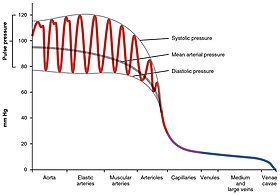
Back ضغط نبضي Arabic Pulsamplitude German ޕަލްސް ޕްރެޝަރު DV فشار نبض FA Pression pulsée French לחץ דופק HE Pressione arteriosa differenziale Italian 맥박압 Korean Pulsa spiediens Latvian/Lettish Polsdruk Dutch
| Pulse pressure | |
|---|---|
 Pulse pressure variation (PPV) in different arteries and veins |
Pulse pressure is the difference between systolic and diastolic blood pressure.[1] It is measured in millimeters of mercury (mmHg). It represents the force that the heart generates each time it contracts. Healthy pulse pressure is around 40 mmHg.[1][2] A pulse pressure that is consistently 60 mmHg or greater is likely to be associated with disease, and a pulse pressure of 50 mmHg or more increases the risk of cardiovascular disease.[1][3] Pulse pressure is considered low if it is less than 25% of the systolic. (For example, if the systolic pressure is 120 mmHg, then the pulse pressure would be considered low if it were less than 30 mmHg, since 30 is 25% of 120.)[2] A very low pulse pressure can be a symptom of disorders such as congestive heart failure.[3]
- ^ a b c Homan TD, Bordes SJ, Cichowski E (12 July 2022). "Physiology, Pulse Pressure". StatPearls [Internet]. Treasure Island (FL): StatPearls Publishing. PMID 29494015. Retrieved 2019-07-21 – via NCBI Bookshelf.
- ^ a b Liaw SY, Scherpbier A, Klainin-Yobas P, Rethans JJ (September 2011). "A review of educational strategies to improve nurses' roles in recognizing and responding to deteriorating patients". International Nursing Review. 58 (3): 296–303. doi:10.1111/j.1466-7657.2011.00915.x. PMID 21848774.
- ^ a b "Pulse pressure". Cleveland Clinic. 28 July 2021. Retrieved 10 February 2023.
If you check your blood pressure regularly and notice you have an unusually wide (60 mmHg or more) or narrow pulse pressure (where your pulse pressure is less than one-quarter of the top blood pressure number), you should schedule an appointment with your healthcare provider to talk about it. [...] Pulse pressures of 50 mmHg or more can increase your risk of heart disease, heart rhythm disorders, stroke and more. Higher pulse pressures are also thought to play a role in eye and kidney damage from diseases like diabetes.